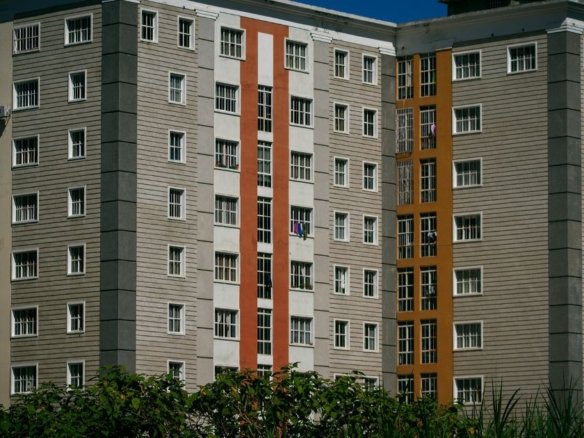When it comes to buying a home, one of the most crucial decisions you’ll make is choosing between a low-rise independent floor and a high-rise apartment. While both options offer modern living, they cater to different lifestyles, priorities, and investment expectations.
Low-rise independent floors usually consist of 2–4 stories, with each floor often sold to a separate buyer. They offer a more private and villa-like experience, usually with fewer neighbors, more open space, and lower density. These are often favored by families who prioritize privacy, autonomy, and a quieter living environment.
High-rise apartments, on the other hand, are part of vertical housing projects that may range from 10 to 40+ floors. These buildings are generally packed with shared amenities like clubhouses, swimming pools, sports courts, elevators, and 24/7 security. High-rise living is best suited for people who enjoy community living, premium facilities, and the convenience of modern infrastructure.
The ideal choice depends on various factors such as:
🏷️ Budget: High-rises may offer lower per sq. ft. costs in premium locations, but low-rise units often provide more usable space for a slightly higher price.
👨👩👧👦 Family Needs: Elderly family members may prefer low-rise homes to avoid elevator dependency, while younger families may enjoy the amenities and social environment of high-rises.
🔐 Privacy vs. Community: If you’re looking for a peaceful, private space, low-rise floors are ideal. For those who prefer an active social life, high-rise communities are a better fit.
🏦 Investment Perspective: Rental income, resale value, and appreciation potential vary depending on location, demand, and infrastructure.
Each has its pros and cons, and the right option should align with your lifestyle, future goals, comfort level, and financial plan.
Let’s explore both options in detail to help you make an informed decision that’s right for you and your family.
🏢 What are High-Rise Apartments?
High-rise apartments are multi-storey residential buildings, usually 15 to 20 floors or more, that cater to urban housing needs by offering vertical living solutions. These buildings are often part of large, planned, gated communities developed by reputed builders and are common in metro cities or fast-growing urban areas where land is scarce but the population is high.
They are designed for efficient land usage, enabling more people to live within the same area footprint—thus becoming a popular choice in places like Mumbai, Delhi NCR, Bengaluru, Hyderabad, and Pune.
✅ Advantages of High-Rise Apartments
1. Modern Amenities
Most high-rise apartment complexes come with a host of modern lifestyle amenities. These can include:
Swimming pools
Clubhouses and community halls
Gyms and fitness centers
Kids’ play zones
Jogging tracks and landscaped gardens
In some premium societies, even shopping plazas, cafes, and co-working spaces are available
These facilities offer residents convenience and luxury within the same campus, saving them the need to travel for basic needs or recreation.
2. Better Security
Security is one of the major highlights of high-rise apartments:
Gated entry and exit with guards
24/7 CCTV monitoring in lobbies, lifts, and perimeters
Biometric or smart-card access in some advanced buildings
Video intercoms connected to main gates
This creates a secure environment for families, women, children, and senior citizens.
3. Community Living
If you prefer social interaction, high-rise living is perfect. With hundreds of families in the same tower or society:
Cultural events and festivals are celebrated together
Children can find playmates easily
Residents often form strong communities with RWAs and resident groups
This communal lifestyle is especially beneficial for families with kids and those who want a vibrant, social neighborhood.
4. Scenic Views & Natural Light
Apartments on higher floors typically enjoy:
Unobstructed cityscape, park, or skyline views
Better air circulation
Less noise pollution
More natural light and ventilation compared to lower levels
This can significantly improve your mental well-being and home ambiance.
5. Affordability in Prime Locations
In the same neighborhood, high-rise apartments can be:
More affordable on a per square foot basis compared to low-rise independent floors
Economically viable due to shared costs of land and infrastructure
This makes it easier for middle-class families to own a home in well-connected, prime areas.
❌ Disadvantages of High-Rise Apartments
1. Elevator Dependency
Living on the 15th or 20th floor means:
You are completely dependent on elevators
In case of power failure, technical issues, or maintenance downtime, access can be difficult—especially for the elderly, toddlers, or disabled individuals
2. Limited Privacy
With 4 to 10 units per floor and common walls, noise and disturbances from neighbors are common
Balconies and windows often face other buildings, reducing a sense of personal space
For people who prioritize solitude or peace, this can be a downside.
3. Maintenance Costs
High-rise living involves significant monthly maintenance fees
Costs go toward upkeep of elevators, lighting in common areas, landscaping, clubhouse facilities, water supply systems, etc.
While it provides convenience, it also means a fixed monthly outflow, often higher than that in low-rise units.
4. Emergency Risks
Fire incidents, earthquakes, or natural calamities require evacuation—much harder in taller buildings
Older high-rises may lack modern firefighting infrastructure
Power failures can leave residents stranded if generators don’t kick in immediately
While newer buildings follow improved safety standards, these risks should still be assessed—especially for families with vulnerable members.
🏘️ What are Low-Rise Independent Floors?
Low-rise independent floors are typically residential buildings with 2 to 4 storeys, where each floor houses a single family unit. These are commonly referred to as builder floors, especially in metropolitan suburbs and Tier-2 cities.
They combine the feel of an independent house with the affordability of an apartment, offering a middle ground for buyers who seek more privacy and space without bearing the full cost of a bungalow or villa.
Low-rise floors are less congested, often located in plotted developments or small colonies, and can offer a more personalized, community-light environment. They may or may not be part of a gated society, and are typically not equipped with extensive amenities.
✅ Advantages of Low-Rise Independent Floors
1. Greater Privacy
With only one or two units per floor, and in many cases independent staircases, there is minimal interference from neighbors.
No shared walls or corridors, which drastically reduces noise and ensures more personal space.
Ideal for people who value solitude, work from home, or live with elderly or young children who require a peaceful environment.
2. Low Maintenance Cost
There are no shared luxury amenities like clubhouses, gyms, pools, or lifts to maintain.
Monthly maintenance charges are much lower, often just for basic services like lighting of common areas or garbage collection.
This appeals to budget-conscious buyers or retirees who want a home with minimal recurring expenses.
3. Less Crowded
A low-rise block usually contains 3–6 families at most, compared to the 100–300+ apartments in high-rise societies.
This translates to quieter surroundings, minimal foot traffic, and reduced wear and tear of common spaces.
4. Independent Entry & Exit
Many low-rise floors offer private or semi-private access, sometimes even with separate gates or staircases.
This gives a villa-like experience without the price of a full-fledged bungalow.
It’s especially desirable for those who value independence, such as senior citizens or professionals with flexible work hours.
5. Better Land Ownership (In Some Cases)
Some builder floor arrangements come with undivided land share, giving the buyer partial legal ownership of the land.
Some also offer exclusive terrace rights or ground floor garden access, increasing the value and usability of the property.
This kind of ownership can be advantageous in terms of resale value or future redevelopment rights.
❌ Disadvantages of Low-Rise Floors
1. Fewer Amenities
These homes lack community features like gyms, pools, sports courts, or clubhouses.
You may need to travel outside the colony or invest privately in fitness or leisure infrastructure.
2. Limited Security
Unlike gated high-rise apartments, low-rise buildings may not have round-the-clock security or CCTV monitoring.
Unless part of a small gated township or unless residents hire private guards, the safety standards depend on local arrangements.
3. Parking Issues
Many low-rise floors offer limited or no covered parking.
Residents often park on the street, which may not be ideal or secure—especially in crowded urban localities.
Parking disputes or space shortages can be common in densely built areas.
4. Lesser Social Interaction
With only a handful of families in the building, the community experience is limited.
This might feel isolating to those who enjoy social gatherings, group celebrations, or networking with neighbors.
5. Maintenance Responsibility
In the absence of a professional management company (as found in high-rises), residents may have to coordinate for:
Water tank cleaning
Sewage/drainage issues
Garbage collection
Repairs or common area upkeep
This can be inconvenient for those who don’t want to take on additional responsibilities.
🏡 Which Is Better for You?
Choosing between high-rise apartments and low-rise independent floors depends on your lifestyle preferences, budget, family needs, and long-term objectives—whether you’re buying for investment or end-use. Here’s a deeper look at which option suits which type of homebuyer:
👉 Choose High-Rise Apartments if:
1. You Want Modern Amenities
High-rise societies are built with a focus on luxury and convenience. If you value access to facilities like:
Clubhouses
Swimming pools
Indoor gyms
Children’s play areas
Walking/jogging tracks
Shopping kiosks or mini-malls within the complex
…then a high-rise apartment is the clear winner. These amenities support an active, balanced, and social lifestyle, especially beneficial for families with children or working professionals.
2. You Like Community Living
If you enjoy:
Participating in festivals, group events, or society meetings
Connecting with neighbors and forming resident networks
Allowing your children to socialize with others in the same age group
…a high-rise fosters this environment. It’s ideal for extroverted families or those moving to a new city where they seek an instant support system.
3. You Prioritize Security and Convenience
High-rises offer multi-layered security:
24/7 guards
CCTV surveillance
Intercom/biometric entry
Monitored visitor access
Additionally, services like on-call electricians, plumbers, and in-society grocery stores or delivery points add to convenience. If safety and time-saving infrastructure are high on your list, go for a high-rise.
4. You Are Investing in a Metro City with Limited Land Availability
In land-scarce cities like Delhi, Mumbai, Bangalore, and Hyderabad, high-rises are often:
More affordable per sq. ft. due to higher density
Located in strategic, well-connected urban zones
More likely to see faster appreciation and rental demand
If your goal is capital growth or rental income, high-rise apartments in metro areas often deliver better returns.
👉 Choose Low-Rise Independent Floors if:
1. You Value Privacy and Independence
Low-rise homes offer:
Fewer shared walls
Minimal foot traffic
Often private balconies, terraces, or separate entrances
This is ideal if you or your family prefer quiet surroundings, solitude, and limited social interaction.
2. You Want a Villa-Like Living Experience on a Budget
Low-rise builder floors give you the look and feel of a standalone home without the massive investment of buying a full villa or bungalow. You may even get:
Terrace rights
Private parking
Small garden spaces (ground floors)
For a spacious, independent lifestyle at a relatively lower cost, low-rise floors are perfect.
3. You Prefer Low Population Density
Fewer families in the building mean:
Less crowding
More peace
Lower noise levels
Greater control over common areas
This is excellent for retired couples, remote workers, or families with elderly members or small children who need a calm environment.
4. You Are Buying for End-Use and Personal Comfort Over Community Features
If your focus is:
Long-term residence
Day-to-day comfort
Less interaction with others
Customizing your interiors and space
…then low-rise units are better suited. Since they often allow more flexibility in interior design and modifications, they’re ideal for owners, not tenants or short-term investors.
🧾 Final Thoughts
Both low-rise and high-rise options have their own merits and drawbacks. Your choice should be guided by your lifestyle preferences, budget, age group, family size, and long-term goals. Also, consider location, legal clearances, construction quality, and builder reputation before making a decision.
At the end of the day, the best home is the one that aligns with your personal needs and offers you peace of mind, comfort, and value for money.





Join The Discussion